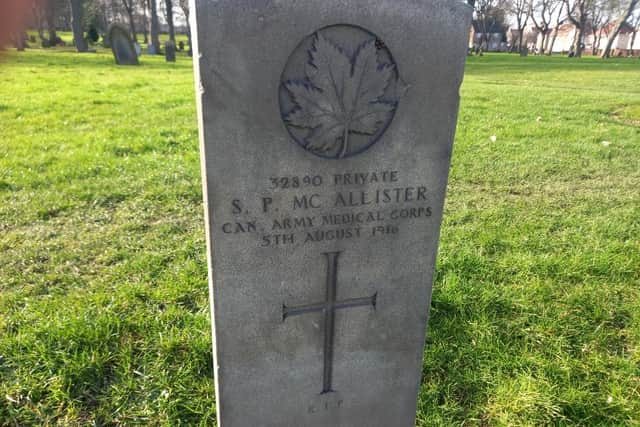Sunderland Echo readers fill in the gaps on the story of soldier's grave in Bishopwearmouth Cemetery
and live on Freeview channel 276
The Echo recently published a feature on Bishopwearmouth Cemetery and some of the people buried there, including MPs, business giants, the founder of Sunderland AFC and even a lion tamer.
However, another intriguing grave is Private SP McAllister’s, whose Commonwealth war grave lies apart from the others in the centre of the site.
Advertisement
Hide AdAdvertisement
Hide AdHis headstone only says: “32890 Private SP McAllister, Can. Army Medical Corps, 5th August 1916.”


The Echo feature said: “Private McAllister’s story is surely fascinating; it’s just that we have no idea what it is.” David Sloan and John Pykett have since provided further details, independently of each other.
The soldier’s full name was Stephen Patrick McAllister, born in Sunderland on August 2, 1887: he therefore died three days after his 29th birthday.
Stephen’s parents were Irish. His father John was a sergeant in the regular army, stationed in Sunderland Barracks.
Advertisement
Hide AdAdvertisement
Hide AdJohn and his wife Margaret moved around a lot and their four children were born in different locations, depending on John’s station.
In 1901 they lived on St Vincent Street and John was working on a new pier, presumably the current Roker Pier, completed in 1903. The 1911 census shows Stephen living with his sister Annie Hunter and her husband in Boldon. All three are listed as “tobacconists”.
Like many young men at the time, Stephen probably emigrated to Canada seek his fortune. Canada was automatically brought into the war after Britain’s declaration of war on August 4, 1914 as it was a British dominion.
Stephen enlisted in the Canadian Army Medical Corps soon afterwards. He was eventually hospitalised near the Somme battlefield and later died of a heart attack.
Advertisement
Hide AdAdvertisement
Hide AdHe was transferred to a Middlesex hospital in March 1916, diagnosed with shell shock and acute heart disease, but is thought to have died in or near Sunderland as his next known address was Station Terrace, East Boldon.
World War One enthusiast David said: “I think it’s a sad story, even for World War One. The people we hear about being killed; it’s usually a heroic story. To be working on the ambulances, he must have seen some horrific things.”
